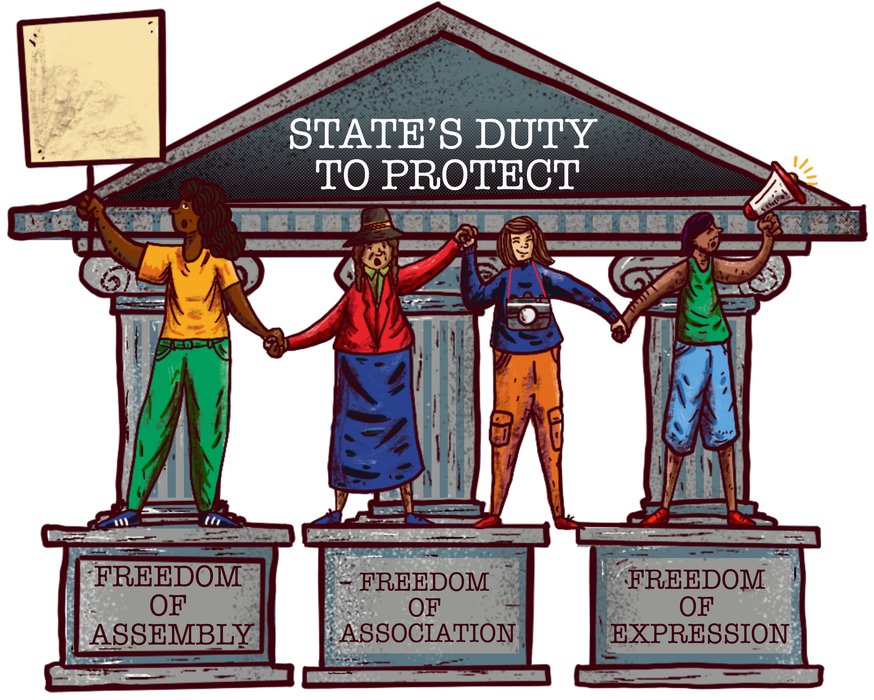Methodology
The CIVICUS Monitor is a participatory research partnership that assesses the state of civic space worldwide and offers insights into civic space developments. We define civic space as the respect in policy, law and practice for freedoms of association, expression and peaceful assembly and the extent to which the state protects these fundamental rights.

The CIVICUS Monitor collaborates with over 20 civil society research partners. These partners periodically produce civic space country updates, often based on information directly obtained from national civil society bodies, that undergo rigorous triangulation and verification processes before being published. In 2024, the Monitor expanded its network to gain more nuanced insights into civic space conditions in Caribbean and Lusophone African countries.
The CIVICUS Monitor consolidates this information to identify top violations recorded throughout the year. Our researchers evaluate each incident documented in the updates, tagging them to specify the civic space violations, those affected and the actions that led to violations. This information allows us to identify the main global and regional civic space trends that are analysed in this report. In the period covered by this report – 1 November 2023 to 31 October 2024 – the CIVICUS Monitor was able to identify over 2,500 incidents where civic freedoms were violated.
By tagging the incidents, we aim to identify the most common tactics of repression worldwide and highlight violations that exemplify the specific challenges each region faces and the ways civic space is being restricted.
Frequently Asked Questions
HOW DO YOU GET TO THE RATINGS?
At the heart of the CIVICUS Monitor’s methodology is the combination of several independent data sources, comprising both quantitative and qualitative data. Firstly, we compile indicators from civil society organisations that evaluate core civic freedoms, including Freedom House's association indicator, V-Dem's peaceful assembly indicator, and Reporters Without Borders' freedom of expression indicator. The second component involves analysing narrative reports from national, regional, and international civil society organisations, providing relevant information on the civic space conditions of each country. Our team follows standardised coding guidelines to ensure consistency, allowing us to compare assessments across countries and over time. These external analyses are then combined with assessments from CIVICUS and our research partners to calculate a score for each country. This score categorises countries as open, narrowed, obstructed, repressed, or closed.
DO COUNTRIES WITH THE SAME RATING EXPERIENCE THE SAME CIVIC SPACE CONDITIONS?
Ratings are conceptualised as broad bands, where a variety of civic experiences can exist within any given rating category. The goal of ratings is to offer robust comparisons between countries over time, meanwhile the scores provide more detailed information on the state of civil society freedoms within those broad categories.
We establish a minimum and a maximum theoretically possible value, representing completely unrestricted (100) to entirely restricted (1) civic spaces. This range is comprehensive enough to encompass this global variety of civic experiences and allows us to confidently assess and compare the state of civic spaces across different countries and territories.
HOW OFTEN DO THE GLOBAL RATINGS AND TOP VIOLATIONS GET UPDATED?
Scores underpinning the ratings and the list of top violations are updated annually following the release of the annual report People Power Under Attack.
What freedoms are included in your documentation?
The goal of CIVICUS Monitor is to provide a comprehensive assessment of the conditions for civil society within countries and over time. Civic space is defined as the respect in law, policy and practice for freedoms of association, peaceful assembly and expression and the extent to which the state protects these fundamental rights. The CIVICUS Monitor conceptualises the conditions for civil society as the respect for these four indicators.
How do you measure civic freedoms quantitatively?
The CIVICUS Monitor combines qualitative and quantitative data inputs generated by primary and secondary research.Recognising that indicators used to conceptualise civic space cannot be directly observed or assessed by a single measure, our methodology constructs a composite indicator to provide an overall view of conditions in each country. To do so, we created a fixed scale which establishes the range of the CIVICUS Monitor, i.e. we impose a minimum and a maximum theoretically possible value. This range encompasses a range of completely unrestricted (100) to completely restricted (1) civic spaces. Given that the state of civic space across all countries and territories vary from very restricted to more open, we can be reasonably confident that the range we set up is broad enough to encompass the variety of civic experiences around the world.
How many countries and territories does the Monitor cover?
We annually rate civics space conditions of 198 countries and territories around the world. However, we specifically publish regular updates for a subsample of around 160 countries, where our research partners provide crucial on-the-ground information, enabling us to offer in-depth insights.